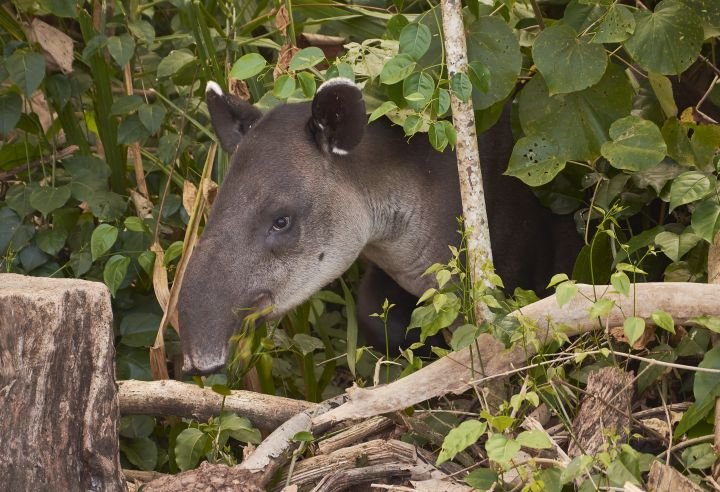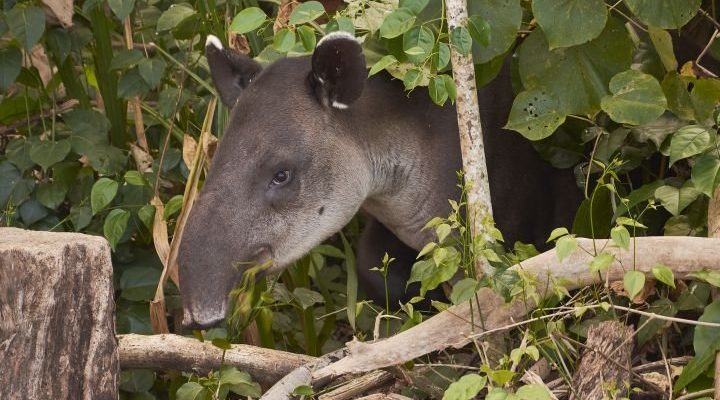
Imagine you’re hiking through a lush, tropical forest, surrounded by vibrant sounds and sights. Suddenly, you glimpse a large, dark shape moving through the underbrush. Before you get too excited about this rare encounter, it’s important to pause and consider your next steps. What do you do? How should you act? Let’s dive into the essentials of encountering a Baird’s tapir safely and respectfully.
Understanding Baird’s Tapirs
Baird’s tapirs, scientifically known as *Tapirus bairdii*, are fascinating creatures. They can weigh between 500 to 800 pounds and stand around 3 feet tall at the shoulder. With their distinctive features—like a rounded body, short legs, and a flexible snout—they are the largest land mammals in Central America. These animals are mainly herbivorous, munching on leaves, fruits, and aquatic plants.
What’s cool about Baird’s tapirs is their secretive nature. They’re mostly nocturnal, meaning they’re active during the night, which can make spotting one a real treat. They prefer dense, rainforest habitats near rivers, which provide both food and water. So, if you’re exploring these regions, you might just cross paths with one!
However, while they may look docile, Baird’s tapirs are wild animals. Like any creature, they can react unexpectedly if they feel threatened or cornered. Being informed about their habits and behaviors can help you navigate an encounter with respect and safety.
Stay Calm and Observant
So, you see a Baird’s tapir! First things first: stay calm. It’s easy to get excited, but remember, sudden movements or loud noises can startle the animal. Instead, take a deep breath and observe from a distance.
Here’s how to do it:
- Keep your distance: Tapirs can feel threatened if you get too close. Aim to stay at least 50 feet away to respect their space.
- Watch their behavior: Are they eating? Moving slowly? These cues can tell you about their comfort level. If they seem relaxed, you can feel okay watching them for a moment.
- No sudden movements: Avoid quick gestures that might spook them. Just enjoy the moment!
By observing calmly, you can gain a deeper appreciation for this unique animal and its behavior.
Do Not Approach or Feed
You might be tempted to get closer or even offer food, but here’s the thing: never approach or feed a Baird’s tapir. These animals are not pets, and feeding them can disrupt their natural foraging behaviors.
Imagine walking into someone’s home and invading their space. That’s essentially what approaching a tapir is like. Here’s why keeping your distance is crucial:
- Stress to the animal: Getting too close can stress tapirs, making them feel threatened. This isn’t just uncomfortable for them; it could push them to react defensively.
- Health risks: Wild animals can carry diseases that may not affect them but could harm humans. Feeding them can also lead to dependency on human food, which isn’t healthy for them.
- Legal implications: In some areas, interfering with wildlife is against the law. Respecting these regulations helps protect these unique creatures.
So, if you want to enjoy a Baird’s tapir sighting, just sit back, relax, and let nature take its course.
Back Away Slowly if Necessary
If a Baird’s tapir notices you and seems uncomfortable, your best plan is to back away slowly. Here’s how to do it effectively:
- Do it gently: Don’t turn your back immediately or run. Sudden movements can trigger a fear response.
- Keep eye contact: As you step back, maintain a relaxed stance and keep your eyes on the tapir. This shows you’re not a threat.
- Move away calmly: Create distance without drawing attention to yourself. Quietly back away until you’re far enough for both you and the tapir to feel safe.
This way, you show respect for the tapir’s space while ensuring your own safety.
Know When to Leave the Area
Sometimes, a tapir might be in a spot that creates potential complications, especially if they’re near a trail or campsite. In these cases, it’s wise to know when to leave the area.
Consider these signs:
- Persistent presence: If the tapir doesn’t move after you’ve backed away, it might mean they’ve claimed that spot as their own. It’s time to head somewhere else.
- Other wildlife: Sometimes, tapirs can attract attention from other animals. If you see more wildlife showing up, it’s a good cue to quietly exit the area.
- Feeling anxious: Trust your instincts. If you feel uneasy about the encounter, don’t hesitate to leave.
Your comfort and safety are important, so don’t worry about missing a moment. There will be other opportunities to see wildlife.
Educate Yourself About Baird’s Tapirs
After your encounter, take some time to learn more about Baird’s tapirs. Understanding their role in the ecosystem is fascinating and rewarding! Here’s why educating yourself matters:
- Conservation importance: Baird’s tapirs are considered vulnerable due to habitat loss and hunting. Knowing their status can help you support conservation efforts.
- Behavioral insights: The more you know about their habits, the better equipped you’ll be for future encounters.
- Share your knowledge: Talk about your experience with others. The more we share, the more awareness we can build around these unique animals.
You might be surprised by how much more you appreciate these creatures once you dive deeper into their world.
Encountering a Baird’s tapir in the wild can be an unforgettable experience. Just remember to stay calm, watch from a distance, and respect their space. These remarkable animals deserve our admiration, but they also require our understanding and care.
By being mindful of your actions and educating yourself about their behavior, you’re not just a spectator; you’re a respectful visitor in their world. So next time you’re wandering through their habitat, be prepared, and enjoy the magic of wildlife, knowing exactly how to act when you find yourself in the presence of a Baird’s tapir. It’s not just about seeing the animal; it’s about connecting with nature in a meaningful way.

